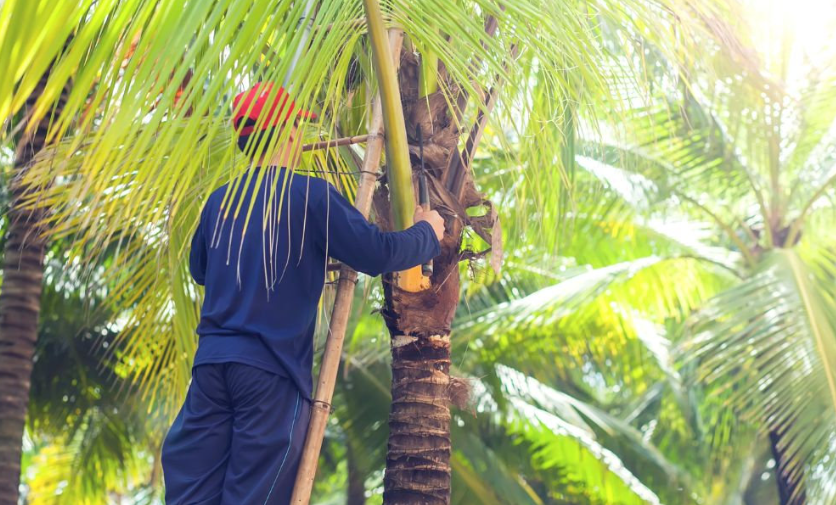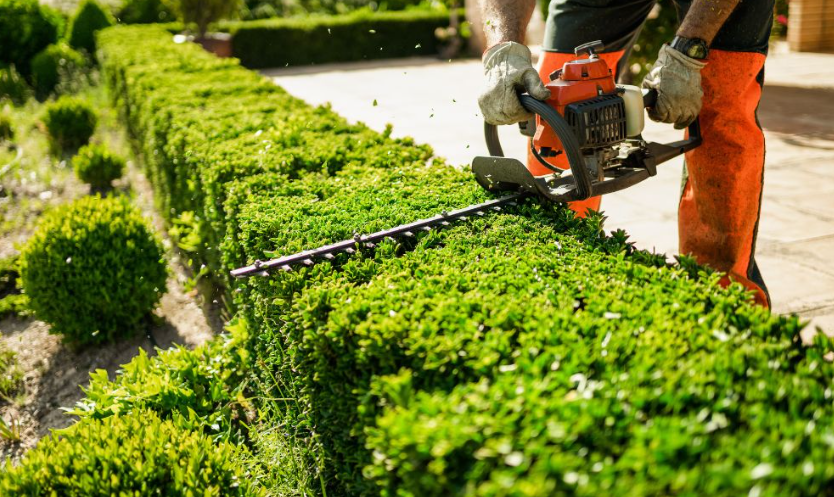How Much to Trim a Palm Tree

How Much to Trim a Palm Tree Got a wild and untamed palm tree in your landscapes? Do you feel the need to trim it, but are confused about how much to trim a palm tree? Good question. Because if you trim too much, you could kill it, and if you do it too little, your yard ends up looking like a jungle. No one wants that. In this guide, we will break it down for you. Be it costs, timings, and tools, we will ensure you know all about trimming so you don’t mess it up. So, get ready to embark on a adventure full of greens. What Does “Trimming a Palm Tree” Really Mean? Palm trees aren’t like oaks or maples. They don’t need trimming for shape. When you basically trim your tree, you are removing dead or dying fronds, old fruit stalks, or anything that poses a danger. It is all about health and safety. You don’t need to overdo as you can stress the tree out and make it vulnerable to bugs. This will kill the tree. So, figuring out how much to trim a palm tree is a balancing act. You want the tree to look good but also stay alive. Why You Should Trim a Palm Tree First off, do you even need to trim it? Yes but not too often. This is why it matters: Dead fronds fall off. They can hurt people or damage property. Rodents and bugs love hiding in overgrown trees. Will keep your looking neat and healthy and even prevent fire hazards in dry climates. Boosts curb appeal big time. When Is the Best Time to Trim a Palm Tree? Timing matters. Most pros say the best time to trim is late spring to early summer. Why? That is when the tree is growing fastest. You will avoid cold-weather shock. Trimming too early in spring means you may need to do it again later. Do not do this: Don’t trim in winter and during a cold snap. Don’t trim just because a few fronds are brown. Brown fronds are normal. So trim only when they are completely dead or dangerous. How Often Should You Trim a Palm Tree? Not every week and not even every month. You only need to trim them once or twice a year but too much pruning is bad. It can lead to: Nutrient loss Bug infestations Weird growth patterns. For different palm trees, there are different trimming frequencies: For Queen Palm, about 1-2x a year. For Mexican Fan Palm, once a year. For the Canary Islands, do it every one to two years. For the coconut palm, once every two years at maximum. Watch for signs like: Dead brown leaves Hanging fruit stalks Fronds blocking sidewalks or windows How Much to Trim a Palm Tree: Basic Cost Breakdown So let’s get down to the money part. How much does it cost? On average, it costs around $75 and $400. But it can increase as well, depending on the tree height. Tree Height Average Cost Under 30 ft $75 – $150 30–60 ft $150 – $300 60+ ft $300 – $1,200 Factors That Affect the Cost of Trimming: 1. Tree Height Taller trees require more labor, which means more money. They might need special ladders, bucket trucks, and safety gear. Tree Species Some palms grow fast and are messy. Others don’t need much maintenance. Like queen palms grow too fast and need regular trims, whereas date palms are tough to prune and expensive to handle. 3. Location Is your palm tree near a fence, power lines, or the roof? This makes things trickier and even pricier. 4. Tree Condition Dead fronds mean extra cleanup. If your tree is affected by pests or disease, it would need more proper handling. 5. Debris Removal Want everything cleaned up and hauled away? You can expect an extra bill added to the overall cost. If you want to avoid overpaying, get multiple quotes and ask if they include cleanup and insurance. DIY vs Hiring a Pro: Which Is Better? Thinking of doing it yourself? You can, but you shouldn’t. There are some advantages like: Save money Learn a new skill Satisfying (if done right) At the same time, there are some disadvantages as well: Dangerous—fall risk, sharp tools Time-consuming No insurance if something breaks Wrong cut = permanent damage Most people end up buying costly tools like pole saws and ladders. While hiring a professional arborist means: They’re insured. They know how much to trim. They clean up. They have got the right tools. How Much to Trim a Palm Tree Based on Type Not all palm trees are the same. Different species tend to grow in different way. Let’s break down some common types. Queen Palm Grows fast Fronds droop quickly Needs trimming 1–2 times per year Cost: $100 – $300 Canary Island Date Palm Big, thick, and slow-growing Can be expensive to trim Needs expert care Cost: $300 – $600+ Mexican Fan Palm Skinny and tall Fronds stack up fast Trimming is quick but often high up Cost: $100 – $250 Coconut Palm Tropical and beautiful Needs regular trimming to remove coconuts and fronds Cost: $150 – $400 Signs You’re Trimming Too Much Yes, you can overdo it as palms are not like regular trees. They only grow from the top—called the crown. Trim too many fronds, and the palm has no way to feed itself. Watch out for these signs: Yellowing or browning at the top (not just lower fronds) No new fronds growing The trunk starts to rot or bend Fungus, pests, or mold Never trim more than 25% of fronds at one time. Best Tools for Trimming a Palm Tree Using the right gear is the secret recipe for the best results. All you need are these basic tools: Pole saw (manual or electric) Pruning shears for smaller fronds Hand saw for thick bases Loppers for medium branches. Wear safety gear as well,
The Best Time of Year to Trim and Prune Trees

Do you want to trim and prune your trees? Well, this may look simple but it depends on the timing. If you cut the branches at the wrong time, you might get stunted growth or even make your tree prone to diseases, eventually killing it. So, one might wonder when is the best time to trim and prune trees? Arborists recommend the dormant season for most of the tree species. This season lies from late winter to early spring. You can also opt for pruning in the summer for some season, but not in fall– it is a bad idea. In this guide, you will get to discover the best time to prune trees and some species-specific pruning schedules. We will also provide you expert-backed tips to keep your trees healthy and thriving in the long run. Why Pruning and Trimming Are Essential Trimming and pruning are not just mere techniques that cut the branches of your tree. It is a crucial part of tree care. From affecting its structural integrity to its disease resistance, pruning matters a lot for your trees Promote healthy growth- Pruning is the selective removal of dead or diseased branches that help your tree redirect its energy for new and healthier growth. Reduced risk of disease- Promotes sunlight penetration and flow of air, thereby making trees less susceptible to vascular fungal diseases and blight. Peer prevention of safety hazards- swell, or weak, laden branches with wind or storm are potential safety hazards on your property. Improves the appearance– Have a more polished aesthetic and beautify the landscape. Improves fruit and flower production – Yields higher fruit production from trees like apple, cherry, and peach. The Best Time to Trim Trees by Season Winter (Late Dormant Season) – The Best Time for Most Trees Ideal timeframe: The latter part of winter, when February and early March roll in, before the new plants start growing. Why Winter Is the Best Season for Tree Pruning Trees are dormant and the rate of metabolic activities is slow. Lower risks of disease and pests – Most diseases and insect activities affecting trees are inactive at colder temperatures. Structure of the trees can be seen with more ease with bare branches – Arborists and homeowners can identify dead, diseased, or weak limbs more easily as the leaves are gone. Strong spring growth – Pruning before the formation of new buds produces healthy branches. Restricts bleeding of sap – For sap-heavy trees like maples, birches, and walnuts. Best Trees to Trim in Winter Deciduous trees (oak, maple, birch, beech) – Prevents diseases. Fruit trees (apple, peach, cherry, plum) – More fruit yield production. Shade trees (elm, ash, sycamore) – Long-term benefit to the health of the canopy. Hardwood trees (oak, hickory, walnut) – Prevents the spreading of pests like oak wilt during the warm months. When Not to Prune in Winter Extremely cold weather – Because cuts from pruning can become dry and prone to cracking. Evergreens – Pruning in winter can stress these trees as they do not become completely dormant. Spring – A Season of Caution for Tree Pruning Ideal timeframe: After the first appearance of growth, late spring. Pros and Cons of Spring Tree Pruning Cleans up winter damage– For trees with broken limbs, or weakened branches due to damage from storms during winter. Necessary for pruning spring-flowering trees— Dogwoods, magnolias, and lilacs should be pruned right after flowering. Fruit development in certain species– Most species can benefit from light pruning of fruit trees after bloom, encouraging fruit production. Bad for energy conservation, Trees need energy from the new leaf and bud development as they actively grow in spring. Sap loss can be greater– For example, maple, walnut, and birch bleed profusely during early spring. Pruning too early can remove buds – Cutting too soon would remove buds for flowers or fruits. Best Trees for Pruning in Spring Spring flowering (only after blooming): dogwood, cherry, magnolia, lilac. Cold-damaged trees, during the winter, if a tree suffered breakage, spring is a good time to remove dead wood. Fast-growing species— Willow, poplar, and silver maple trees should be thinned in early spring. Trees to Avoid Pruning in Spring Oak trees – Increases the risk of oak wilt disease. Evergreens – Trimming early summer gives the best results rather than in spring. Sap-heavy trees– Causes excessive sap flow in maple, birch, and walnut. Summer – Ideal for Growth Control and Disease Prevention Ideal timeframe: Mid-to-late summer (July-August). Why Summer Pruning Can Be Beneficial Controls excessive growth – Manage overgrown branches Improves tree structure – Shapes the canopy by identifying crossing or weak branches. Encourages flowering next year – Trees, like crape myrtle and wisteria, set flower buds for the next season. Prevents fungal infections – Trees pruned heal faster in summer compared to damp fall weather. Removes hazardous limbs – Summer storms make structural pruning essential as it breaks heavier branches. Best Trees to Prune in Summer Overgrown shade trees – Elm, ash, sycamore, honey locust. Evergreens – Maintain shape without excessive stress. Fruit trees – Ripen more effectively as dense branches are thinned out. Flowering trees and shrubs – Pruning on species like wisteria and crape myrtle produces more flowers. What Not to Prune in Summer Oak trees – Oak wilt is spread by beetles that are most active in summer. Heavily stressed trees – If your tree is struggling from drought or disease Trees which are already pruned in spring. Fall – The Worst Time for Most Tree Pruning Ideal timeframe: Avoid pruning unless necessary. Why Fall Pruning Should Be Avoided Slower healing process- Trees are preparing for dormancy and will not heal cuts well. The increased chance of disease – During fall, the fungal infections like Dutch elm disease and oak wilt are easily spread. Weaken tree structure before winter – Pruning in fall makes trees vulnerable to snow and ice damage. Insects are still active – Fresh pruning cuts attract pests such as borers and beetles. When




